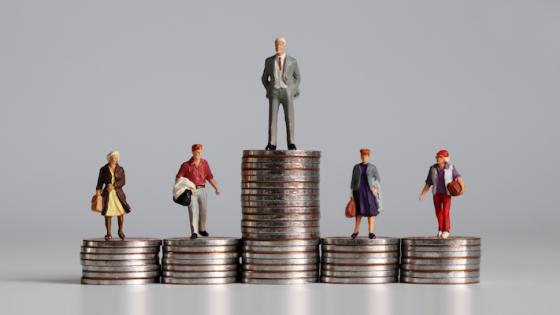Following Piketty’s magisterial tome, Capital in the Twenty-First Century (Piketty 2014), the topic of wealth inequality has garnered quite a bit of attention amongst academics as well as in the popular press. Recent VoxEU contributions to the topic include Iacono and Ranaldi (2020), Kanbur and Stiglitz (2015) and Nolan et al. (2020).
It is easy to see why wealth inequality seizes the popular imagination when the world’s richest man, Jeff Bezos, is worth $200,000,000,000 while the median American has net assets of just $121,000. In a new working paper (Bouchaud and Farmer 2020) we argue that the vast inequalities we see in the world distribution of wealth are deeply connected to a somewhat esoteric concept from the theory of stochastic processes. The world is quasi-non-ergodic.
Ergodicity has also been trending in the news as the physicist Ole Peters (Peters 2019) has made the bold claim that, to quote a Bloomberg article that publicises his work, “Everything We’ve Learned About Modern Economic Theory Is Wrong”, (Kochkodin 2020). These are strong words and while we do not agree with all of Peters’ critique of economics, we do think that economists have relied for far too long on the unwarranted assumption that the social world is ergodic. Indeed, this was the topic of a conference we co-organised at the University of Warwick in 2018 and that one of us reported on here on Vox (Farmer 2018).
Our new working paper, “Self-Fulfilling Prophecies, Quasi-nonergodicity and Wealth Inequality” (Bouchaud and Farmer 2020) has two intertwined themes. The first is that it is impossible to accurately predict the future by averaging over what has occurred in the past. The second is that the inability to learn from experience implies that reasonable people will continue to disagree forever. Together, these two observations explain why, in the real world, wealth is so much more unequal than income.
Our taking off point is the Pólya urn model reviewed in Pemantle (2007). In this model, an urn contains M red balls and (N−M) black balls. A ball is chosen at random. If it is red (black) then 2 red balls (black balls) are re-introduced in the urn, which now contains N+1 balls. The probability of drawing a ball with a specific colour therefore increases with the number of times this colour was selected in the past.
The long-term fate of the Pólya urn is surprising. As the number of draws tends to infinity, the probability to draw a red ball converges to a limiting value; but the value of this asymptotic probability is itself random. Starting from the same urn with N red balls and M black balls, two different runs of the dynamics will lead to two limiting probabilities. To completely characterise the behaviour of this process, one must introduce probabilities over probabilities. The dynamics of the Pólya urn are non-ergodic.
In our paper, we build a model in which beliefs are described by a process, similar to the Pólya urn, but where there is no convergence to a number; instead, the probability of a given outcome is a random variable that converges to a limiting distribution. Stochastic processes of this form, where probabilities are themselves random variables, are referred to in physics as quasi-non-ergodic. In these models the averages of very long time series have the same mean as the mean of the invariant probability measure, but the length of time for that result to hold is astronomically long.
In our model, people trade assets contingent on an observable signal that reflects public opinion. The agents in our model are replaced occasionally and each person updates beliefs in response to observed outcomes. Interestingly, people continue to disagree forever, even though they are able to trade with each other in a complete set of financial markets. Trade continues because everyone believes that they know more than the market.
Our model generates large wealth inequalities that arise from the multiplicative nature of wealth dynamics which makes successful bold bets highly profitable (as in Bouchaud and Mézard, 2000). The flip side of this statement is that unsuccessful bold bets are ruinous and lead the person who makes such bets into poverty. People who agree with the market belief have a low expected subjective gain from trading. People who disagree may either become spectacularly rich, or spectacularly poor.
In the paper, we simulate 300 years of weekly data for an economy with a million people and we show that equity prices in the model mimic equity prices in the real world. The outcome of this process is the wealth distribution in Figure 1. The Gini coefficient, a measure of inequality, is 0.7 in these simulated data, close to the wealth Gini’s we see in Western economics.
Figure 1 The Lorentz curve in simulated data

Why do people continue to bet with each other when these bets are highly risky? The answer we propose is that everyone in our economy thinks that the market is wrong and that by betting, they will be able to make money on average. They do not use the implied probability revealed by the markets to improve their estimates of true probabilities since this trading strategy is, in their opinion, sub-optimal.
I started this post by draw attention to the wealth of the world’s richest man. One might ask: Why is Jeff Bezos so much richer than the median American? One answer is that Jeff Bezos created a company that has enormous social value and, as a consequence, his income is much greater than that of the average person. But although income isunequally distributed in the real world, income dispersion is not great enough to explain wealth inequality. In our model, everyone has the same income, but wealth is still highly concentrated because some people are luckier than others.
Why are there no Warren Buffets who invest for the long run? Our answer is that for any reasonable time period, the future is better approximated by averaging the frequency of recent observations than by assuming that the next draw of the stock market price is drawn from its unconditional long-run distribution. In the long run the market is correct. But, as Keynes famously quipped: “In the long run we are all dead”.
References
Bouchaud, J-P and R E A Farmer (2020), “Self-Fulfilling Prophecies, Quasi-nonergodicity and Wealth Inequality”, CEPR Discussion Paper 15573.
Bouchaud J-P and M Mézard (2000). “Wealth condensation in a simple model of the economy”, Physica A: Statistical Mechanics and its Applications, 282: 536-545.
Farmer, R E A (2018), “Ergodicity: Is the past probable?”, VoxEU.org, 11 April.
Nolan, B, J C Palomino, P Van Kerm and S Morelli (2020), “The intergenerational transmission of wealth in rich countries”, VoxEU.org, 19 September.
Pemantle, R (2007). “A survey of random processes with reinforcement”, Probability Surveys 4: 1—79.
Peters, O (2019), “The ergodicity problem in economics”, Naturephysics 15: 1216-1221.
Iacono, R and M Ranaldi (2020), “The wage curve across the wealth distribution”, VoxEU.org, 2 November 2020.
Kanbur, R and J Stiglitz (2015), “Wealth and income distribution: New theories needed for a new era”, VoxEU.org, 18 August.
Kochkodin, B (2020), “Everything We’ve Learned About Modern Economic Theory Is Wrong”, Bloomberg Economics, 11 December.
Piketty, T (2014), Capital in the Twenty-First Century, Harvard University Press.




